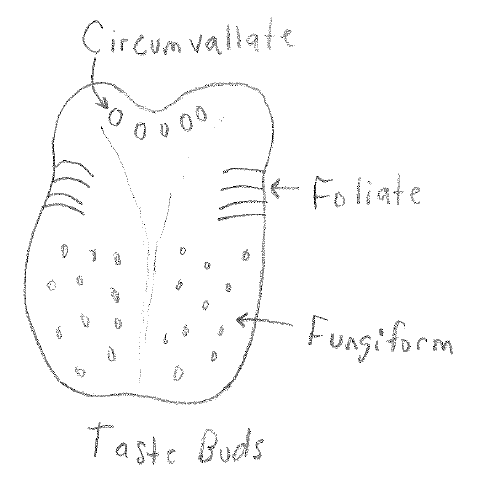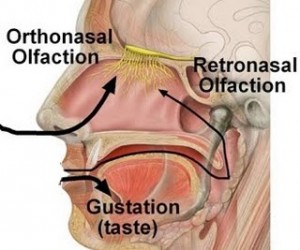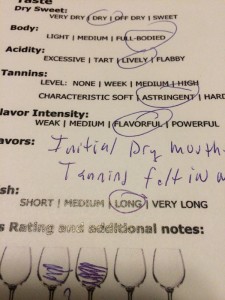

This blog is designed to spend some time on discussing “tasting”. The first thing we’re going to review is the tongue, which is only capable of tasting five things; sweet, sour, bitter, salty and most recently Unami. In order to taste anything, we have to have the compound dissolved on our tongue. (For this blog that would be wine!) It has to enter the taste pore and it has to be responded by the taste cells. Our taste buds are found scattered across our tongues. The ones that we have in the back are the so-called circumvallate papillae, which are dome-shaped structures on the human tongue that vary in number from eight to twelve and found towards the back base of the tongue. We also have the foliate papillae (short vertical folds) that are found on the edges of both sides of your tongue, and we also have the fungi-form papillae, which are scattered across the top surface of the tongue, but mainly at the tip and lateral margins of the tongue.
OK, so that is a lot to talk about and I thought my picture drawing would help illustrate this.

The tongue
Another thing to point out is a study conducted by Dr. Bartoshok that shows that all taste buds taste all five sensory items. In the past people talked about sour taste on the sides, sweet in the front and bitter on the back. This is not true.
So lets evaluate the sensory tastes.
Sweet and sour
These two are probably the most important when it comes to tasting a wine. Sweet is not usually detectable if we have less than 1% sugar as in most red and white wines. Port and some Riesling are considered sweet. Keep in mind that a sweet smell and a sweet taste are different. For instance, a sweet smell including things like honey and butterscotch. If you say “this tastes like honey” you actually mean the wine smells of honey. It can only taste sweet due to glucose, fructose and sucrose, which are all sugars.
Sour is the equivalent to tart and comes from the acids in wine. If there is no acidity in the wine it will be flat and even watery and may not age very well. If there is too much acidity in your wine it will be very tart and make your mouth water a lot while drinking it.
Bitter and astringent
Bitterness in wine comes from the tannins. You may recall that tannins are in the skins and the seeds and are more often felt in red wines. Because red wines include more of the skins and seeds, they tend to be more bitter than white wines. Tannins are also astringent. Astringency, however, is not a taste nor an aroma; it is a mouth feel sensation. It occurs when the tannins interact with the proteins in the mouth. This interaction dries out the mucosal membranes and you have the sensation of dryness or the wine can make you pucker. As wine ages, so does the astringency; but what is important is that the wines include tannins because they cause the wine structure that enhances the mouth feel.
If you open a bottle of wine and you do not care for the mouth feel, I suggest you try eating something sweet and then retry it. The sweetness in your mouth should soften the tannins and make the wine more palatable for you. Salt on the other hand will make a softer mouth feel wine more dry.
So when you are tasting various wines beware of the foods you are eating with the wine because one day you could love the wine and the next, not prefer it simply because of the food you are pairing with that wine.
Alcohol
Wine also contains ethanol, which is organic solvent that acts as a preservative and a flavor enhancer. Ethanol can feel hot, taste sweet, and bitter to some people. It smells very much like alcohol and you will notice it right away. In low concentrations it can make a wine feel more smooth and full-bodied. I have noticed that in wines over 15.5% percent you can clearly smell and taste the alcohol. I recently had a Zinfandel wine that was 16.1% and found that it was too sweet for me and not enjoyable at all.
Overall flavor
Wine’s flavor is the combination of the aroma that we smell in the nose, (either ortho-nasal or retro-nasal and I’ll speak more on this later), the taste that comes from the taste buds, and any mouth feel sensation.
The combination of aroma, taste, and mouth feel sensations is what we collectively call the “flavor” of a wine
Orthonasal and Retronasal Olfaction
Orthonasal Olfaction is the first of two ways we perceive smell. As you can see from the diagram below, the arrow going up into the nose from outside of the body, most of us would call these things smells. If I stick my nose in the glass, it smells of cherries. However, when I take a sip of that wine and breathe out while the wine remains in the mouth, there is odor compounds going from inside the mouth, up the back of the throat, past the olfactory system. This is retronasal olfaction, which would then allow the smell the cherry in that wine while it’s in the mouth. One might tend to call it cherry taste, but we are really talking about cherry smell.
 Source: http://www.drsharma.ca
Source: http://www.drsharma.ca
Reviewing the tasting sheet
In the tasting section of my wine tasting sheet, I have seven categories to help you rate the wine. I tried to keep them in order as you taste the wine.
Dry Sweet – As you taste the wine is it sweet or very dry?
Body – Does it feel light or full-bodied?
Acidity – Is the wine very acidic (very tart, watery mouth feel) or flabby.
Tannins – Do you feel tannins and how do they feel (dry or soft)?
Flavor intensity – Are there any flavors or is it like drinking water?
Flavors – Sweet, sour, astringent?
Finish – How long?

And finally how do you rate it based on my rating system? You may change your mind as you sip the wine. I would advise on a clean palate (no food and drink water) as you initially taste the wine. After your initial ratings, try it again with food. I also advise allowing a glass of wine to sit for some time and re-taste. At times I have used my wine vacuum and re-corked and tried the wine the following day. Take your time and have fun as you try wines!
In Vino Veritas!
![]() Facebook.com/BillsWineWandering
Facebook.com/BillsWineWandering
![]() @BillsWineWander
@BillsWineWander


